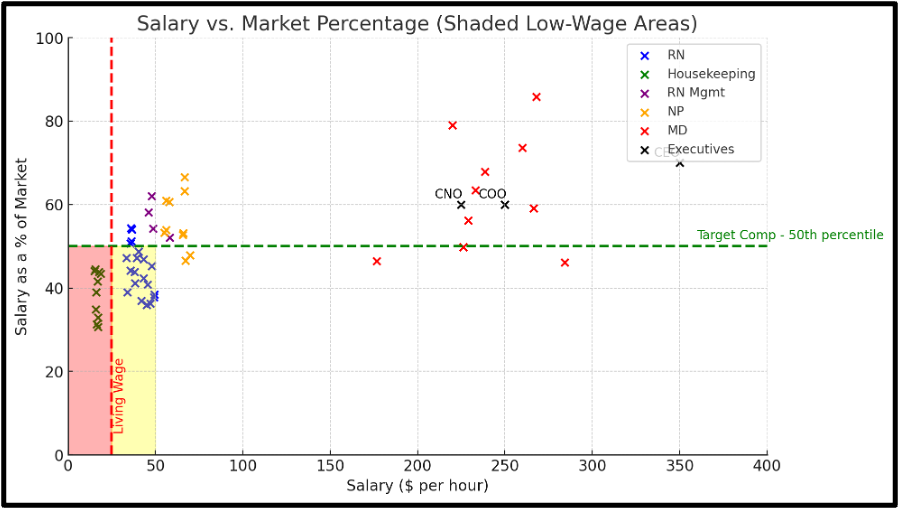
Kada Health News & Insights
Whitepaper: Investing in Our Employees – The Value of Competitive and Equitable Compensation
BROWSE BY CATEGORY
"Investing in Our Employees. This starts with compensating them fairly and providing important benefits."
From the Business Roundtable’s Statement on the “Purpose of a Corporation," January 9, 2025.Download the PDF Great organizations recognize that delivering high-quality products and services is directly linked to investing in employee well-being.
Employees perform at their best when they take pride in their work, possess expertise in their field, have mastered the systems and processes of the organization, feel valued, and are fairly compensated. A structured and transparent approach to setting employee compensation is necessary for retaining talent, fostering engagement, and ensuring long-term organizational success.
Retention: A Business Imperative
As employees gain experience and expertise, their value to the organization increases. Retention of skilled personnel strengthens institutional knowledge, which enhances operational efficiency and improves service quality. Conversely, turnover leads to loss of expertise, which can result in systems functioning below their optimal standard. Additional costs come in the form of hiring and training new employees. This is a common outcome in organizations where the team complement is constantly shifting. Providing appropriate compensation is key for reducing turnover and maintaining a stable, high-performing workforce.
Key Considerations for Compensation
Organizations must ensure that compensation is both competitive and equitable:
1. Market Competitiveness: Pay should meet or exceed the compensation staff can receive within the organization’s local market.
2. Internal Equity: Salaries should be fair to maintain morale and organizational integrity.
Failure to meet these goals can lead to dissatisfaction, high turnover rates, and difficulty in attracting qualified personnel. Annual compensation surveys, using a data-driven methodology, can help organizations maintain fairness and competitiveness of pay.
Visualizing Compensation Data: A Powerful Decision-Making Tool
A structured approach to evaluating pay equity and competitiveness involves visualizing compensation data through a scatter plot analysis. This method provides leadership with a clear view of how compensation compares to market rates and internal benchmarks.
How It Works (Constructing Your Scatter Plot)
- X-Axis: Hourly pay rate (dollars per hour).
- Y-Axis: Compensation as a percentile of market pay standards.
- Key Indicators:
- Employees earning below the living wage threshold (red zone) are at the highest risk and require pay adjustments.
- Staff compensated below the organization’s stated philosophy (e.g., 50th percentile, green line) should be prioritized for pay adjustments.
- Market competitiveness gaps can be identified at all levels, ensuring compensation strategies align with retention and recruitment goals.
Visualizing Employee Compensation
Below is an example of how compensation data can be visualized using a scatter plot. This chart illustrates pay distribution and highlights key areas for adjustment in this hypothetical example for a health system that has stated its pay philosophy is to compensate staff at the 50th percentile.
Interpreting the Data
This exhibit highlights areas of concern where:
- Low-wage employees (left side of the chart) are the farthest below market rates, making them a priority for adjustments. Those in the red zone are compensated less than the level of compensation adopted by leadership as a “living wage.” They are both below the living wage line and below the market standard and thus are the top priority for pay increases.
- Employees in the yellow zone are paid below the target compensation philosophy. They should receive increases after adjustments are funded for staff in the red zone.
- Higher-wage employees paid below the 50th percentile should be candidates for adjustments in pay once the organization has funded increases for staff in the red and yellow zones.
- Executive employees are earning more than most all staff and are also above the organization’s stated compensation standard. The CEO’s pay is near the 70th percentile, far greater compared to market than most all of the frontline staff. A more equitable approach would see executive compensation and those paid the lowest wages at or around the same 50th percentile compensation standard. Peter Drucker advocated that CEO compensation be capped at a 20-to-1 ratio of average worker pay to foster a fair work environment and prevent employee resentment. This tool provides an opportunity for the executive team and Board to consider leadership’s pay relative to the average pay of staff.
A Roadmap for Action
-
- Assess Current Compensation: Conduct an annual review of employee pay data.
- Identify Disparities: Use scatter plot analysis to pinpoint pay gaps with regard to equity and market.
- Prioritize Adjustments: Address the most critical compensation gaps first.
- Implement Incremental Increases: Balance budget constraints while moving employees toward market-aligned pay and the compensation philosophy for the organization.
- Communicate Transparently: Engage employees in the process, reinforcing the organization’s commitment to fair pay.
Conclusion: A Commitment to Fair and Competitive Compensation
A well-managed organization prioritizes competitive and equitable compensation. By utilizing a structured, data-driven approach to salary assessment, leadership ensures alignment with market standards, promotes employee retention, and enhances overall organizational performance. Implementing these strategies fosters a motivated workforce, strengthens institutional knowledge, and supports long-term success.


